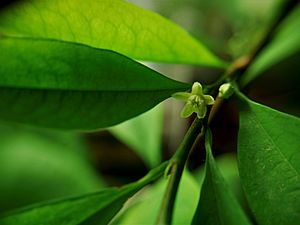Erythroxylum novogranatense facts for kids
Quick facts for kids Erythroxylum novogranatense |
|
|---|---|
 |
|
| 5-year-old E. novogranatense var. novogranatense | |
| Scientific classification | |
| Genus: |
Erythroxylum
|
| Species: |
novogranatense
|
Erythroxylum novogranatense is a type of plant found in the neotropical regions, which means areas in the Americas with a tropical climate. It belongs to the Erythroxylum plant family.
Contents
What's in a Name?
The name "Novogranatense" comes from two Latin words: novo, meaning "new," and granatense, meaning "Granada." This plant was named by William Turner Thiselton-Dyer. He was the third director of the Royal Botanic Gardens, Kew. It got its name because it came from a place called the Viceroyalty of New Granada. This old Spanish colonial area is now known as Colombia.
Different Kinds of Erythroxylum novogranatense
Erythroxylum novogranatense has two main types, called subspecies:
- Erythroxylum novogranatense var. novogranatense
- Erythroxylum novogranatense var. truxillense
These two subspecies look quite similar. However, you can tell them apart by looking closely at their physical features.
How Scientists Classify This Plant
Scientists first thought Erythroxylum novogranatense was the same as another plant, E. coca. Later, they realized it was a different type, or variety. Finally, they decided it was its own unique species.
The Erythroxylum novogranatense var. novogranatense originally grew in Colombia and Venezuela. But this plant is very good at adapting to new places. It's also easy to grow. Because of this, it has spread widely across tropical parts of the Old World and New World.
For example, it was brought to Bogor in Indonesia in 1875. By 1888, many seeds were being sent to other parts of South-East Asia. You can now find it growing in Peninsular Malaysia, parts of Java (Indonesia), northern Borneo (Indonesia), northern Sulawesi (Indonesia), and Luzon in the Philippines.
The other type, Erythroxylum novogranatense var. truxillense, grows in dry areas of northern Peru. Interestingly, neither of these two types has been found growing wild. They are only known from cultivated plants.
Where Erythroxylum novogranatense Grows Best
Erythroxylum novogranatense is a plant that naturally grows in high-altitude areas. However, it is often grown in lower areas too. In South America, it is grown in drier regions. There, it needs to be watered regularly.
This plant is very flexible. It can grow well in many different environments. It thrives in both humid and dry places. It also grows at both low and high altitudes. In Java, Indonesia, E. novogranatense has been grown from sea-level up to about 1,000 meters high. It grows best between 400 and 600 meters.
Studies show that the best temperature for its leaves to grow is around 27 degrees Celsius. Leaf growth is also better when there is more light. This plant grows well in soils that are a bit acidic. The best soil pH for it is between 4.7 and 6.0.
How to Grow Erythroxylum novogranatense
Most types of Erythroxylum, including E. novogranatense var. novogranatense and E. novogranatense var. truxillense, need to be grown from seeds. It's hard to grow them from cuttings. However, one type, E. coca var. ipadu, does not produce seeds. It can only be grown from stem cuttings.
The cultivated E. novogranatense var. novogranatense produces many seeds. It is easy to grow from these seeds. But the seeds don't stay good for long. For example, seeds of E. novogranatense can lose their ability to sprout very quickly. After just 24 days of storage, almost none of them will grow.
Young plants are usually started in shaded nurseries. When they are about one year old and 20–25 cm tall, they are moved to the field. Farmers plant them about 1–2 meters apart. The exact timing and spacing depend on the weather and if other crops are grown nearby.
Farmers in South America have a trick for choosing good seeds. They put the seeds in water. Any seeds that float are thrown away because they won't grow.
How to Identify Erythroxylum novogranatense
You can tell E. coca and E. novogranatense apart by their leaves. E. coca usually has larger leaves. They are more oval-shaped and wider in the middle. Their color is a darker green on top.
E. novogranatense has smaller, narrower leaves. They are widest near the tip and are a bright green color on top.
To tell E. novogranatense var. novogranatense from E. novogranatense var. truxillense: Look at the leaves of E. novogranatense var. truxillense. They do not have the parallel lines on either side of the central vein that other varieties do.
Harvesting the Leaves
The first time you can harvest leaves from Erythroxylum novogranatense is usually 1 to 3 years after planting. In Java, Indonesia, you might get a first harvest within a year.
The leaves are ready to be picked when they feel stiff and can be easily detached from the plant. During the rainy season, leaves can be harvested every 50–60 days. In drier times, they are usually harvested every 3–4 months. It's important to pinch the leaves off the plant, not rip them.
See also
 In Spanish: Coca colombiana para niños
In Spanish: Coca colombiana para niños


